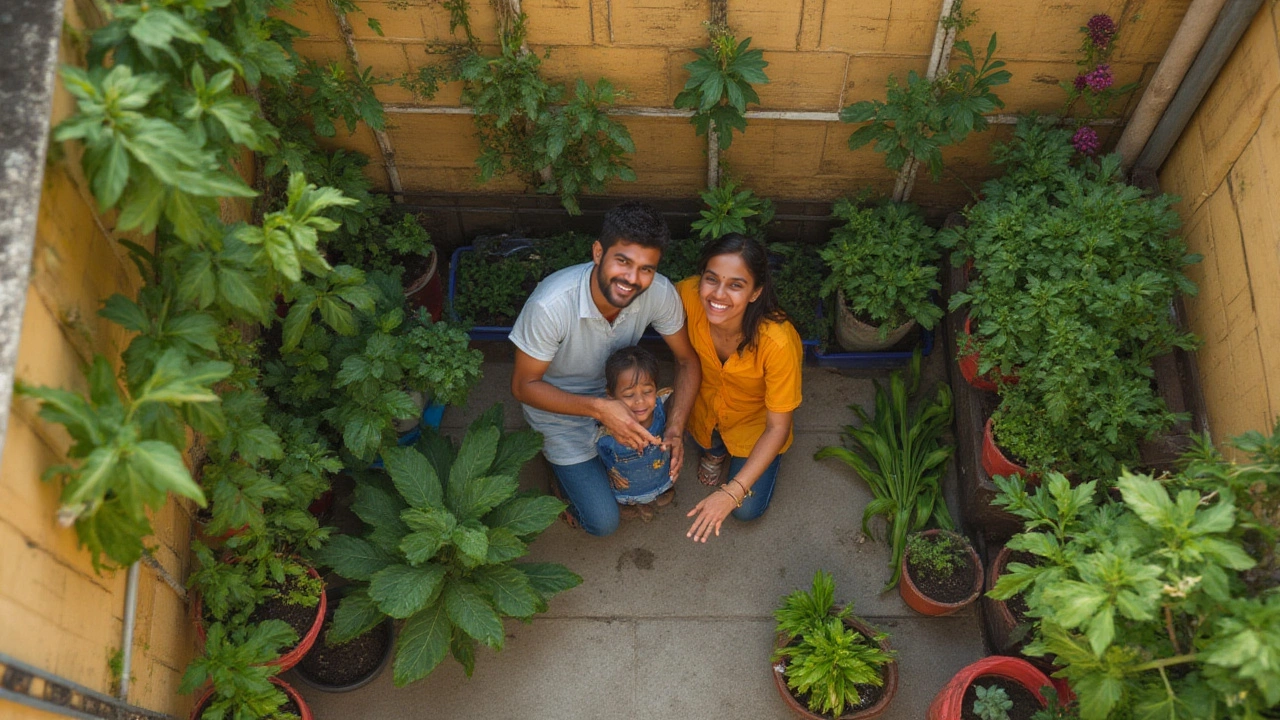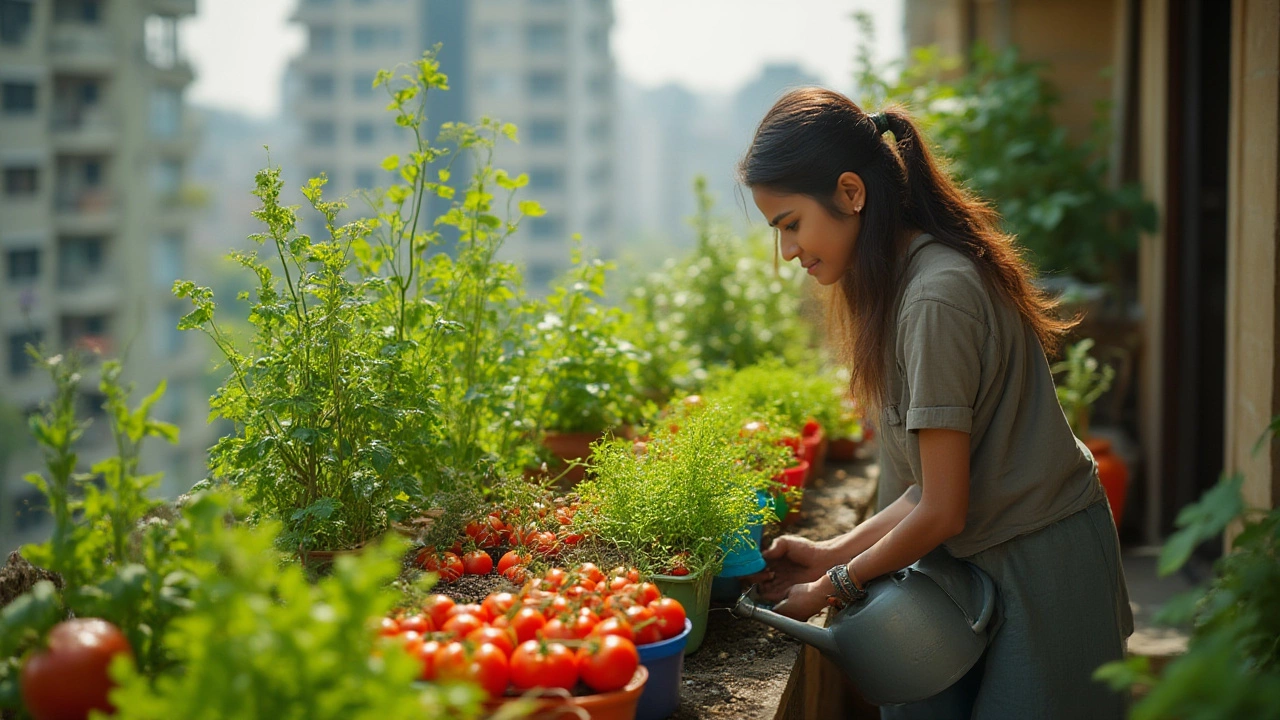Imagine biting into a cherry tomato you just picked two feet from your couch. That’s not some hipster fantasy or a scene out of a futuristic city—millions of folks already harvest real food from balconies barely bigger than a yoga mat. Space doesn’t have to be a dealbreaker, and your concrete slab can transform into a lush patchwork of green, edible life. People have started growing everything from hot peppers to dwarf eggplants high above city streets. And the results? Fresher flavor, total control over pesticides (or lack of them), and a view that beats staring at your neighbor’s recycling pile.
What Vegetables Can You Actually Grow on a Balcony?
Some people think balcony gardens are only good for basil or a single wilted strawberry plant. Not true. You’d be surprised how many vegetables are more than happy to thrive in pots, boxes, or bags—if you play the game smart.
Grow vegetables on balcony isn’t just an Instagram trend—there’s real science behind why it works. Let’s break down why container gardening is so effective, and which veggies play nice with limited floor space and hours of sun.
| Vegetable | Min. Pot Depth (in) | Full Sun | Harvest Time |
|---|---|---|---|
| Cherry Tomato | 12 | Yes | 60-70 days |
| Radish | 6 | Partial | 20-30 days |
| Leaf Lettuce | 6 | Partial | 30-45 days |
| Mini Bell Pepper | 10 | Yes | 60-90 days |
| Carrot (short type) | 9 | Partial | 60-70 days |
| Spinach | 6 | Partial | 25-35 days |
| Green Beans (bushy) | 8 | Yes | 50-60 days |
| Dwarf Eggplant | 12 | Yes | 80-95 days |
Tomatoes are “starters” for balcony gardens. Cherry tomatoes especially—they don’t need much root depth, thrive in containers, and give you handfuls of fruit for salads and snacks. Lettuce, spinach, and other leafy greens don’t mind shallow soil and actually prefer half-shadow, which is perfect if your balcony only gets a few hours of sunlight. Things like radishes and short carrots rush through growth cycles, so you can plant, eat, and plant again within months.
Still worried you’ll just end up with scraggly plants? Plenty of city dwellers load balconies with bush beans, hot peppers, kale, even compact versions of cucumber. Balcony gardening isn’t just possible in theory—the city of Singapore actually runs a campaign called “Edible HDB” where high-rise residents compete to grow the largest veggie crops in boxes on their units.
Choosing the right plant starts with knowing your balcony’s vibes. Is it blazing hot afternoon sun? You’re set for tomatoes, peppers, and eggplants. Partial shade? Rule the world of lettuce and spinach. Do a quick Google check for “dwarf” or “compact” versions, because breeders have actually designed these for small space and pot culture.
And don’t ignore weird but fun options like microgreens (harvested in 10-14 days), or root crops made for containers. Proven varieties: ‘Little Finger’ carrots, ‘Patio Choice’ cherry tomatoes, ‘Salad Bowl’ loose-leaf lettuce—they’re bred for tight spots.
Herbs deserve a quick mention too: basil, thyme, mint, cilantro, and chives work as edible borders or mixed in with the other veggies. But let’s stick to the real stars—the classic vegetables.
If you want real-life proof, check out a quote from organic gardening expert Joe Lamp’l:
"Don’t underestimate what a few square feet and some sunlight can accomplish. Even with just a balcony, you can grow your own salad bar—no backyard needed!"

The Practical Side: Balcony Garden Setup, Soil, and the Art of Tiny-Space Growing
Nobody wants to drag forty-pound bags of dirt through an apartment or deal with cracked pots. If you play this smart, growing vegetables on a balcony is way easier—and way less messy—than it sounds.
First, check your balcony rules. Some apartments get fussy about water runoff or weight. Most structures can handle a couple of medium planters, but big raised beds might be a bad idea if your place is old or the landlord is hyperventilating every time you mention “compost.” Stick with lightweight plastic or fabric pots—they look sharp, stay much cooler than black plastic, and can be rearranged easily if you need to switch things up.
Drainage is non-negotiable. Regular garden soil turns to mud in a sealed pot. Go for bagged potting mix labeled “veggie blend” or “container mix.” These have coconut coir or peat moss, extra nutrients, and bits of perlite (the white flecks), so air and water move easily. Never scoop up dirt from a city park—bad news for both your veggies and your nose.
Sunlight is where most new balcony gardeners get tripped up. How much does your spot actually get? Here’s a trick: on a sunny weekend, step outside with your phone and snap a photo every hour from sunrise to sunset. You’ll see exactly which pots roast in the heat and which hide in the shade. Most fruiting veggies (tomatoes, peppers, eggplants, beans) want at least six hours of direct light. Greens and roots are cool with less, even three to four hours, so mix them around.
Tools for this mini-jungle? Keep it simple. A trowel, pruning scissors, and a sturdy watering can with a long spout for reaching those awkward corners—that’s enough for 95% of jobs. If you want to geek out, indoor grow lights or moisture meters help; but honestly, you’ll get away just fine without them.
Here’s a big pro tip: group pots together, tight as you can. Plants shade each other’s roots, slow moisture evaporation, and even help fend off some pests. It also just looks good—a lush green corner beats a random pot on every step. Stack and hang planters to use vertical space. Rail planters and wall pockets make more room for rooting veggies like lettuces, chard, or trailing beans.
Fertilizing matters more in a pot than a backyard patch because nutrients wash out fast when you water. Grab a basic organic slow-release fertilizer at the store, or make liquid feeds with worm castings or compost tea every 2-3 weeks. Water with purpose: aim for early morning before the sun gets crazy, so leaves don’t scorch and roots absorb the most. Use your finger or a cheap moisture meter—don’t just water on a schedule, since balconies can dry out wicked fast during a July heatwave or stay damp for days after rain.
- Use drip trays under pots to catch excess water (and avoid making enemies out of neighbors below).
- Rotate pots every week for even growth and sunlight.
- If wind is wild where you live, create windbreaks using bamboo, netting, or a taller planting box to shield young seedlings.
- Check for pests. Balcony gardens may dodge some bugs, but aphids and spider mites sneak in on the breeze or borrowed plants. Keep a spray bottle with mild soapy water for a quick fix.
Pollination can sometimes be tricky up high, since bees and butterflies don’t always fly balcony routes. Tomatoes and peppers self-pollinate—just shake their stems gently every few days, or use a soft brush to transfer pollen. Squash and cucumbers sometimes need a little manual hand-pollination for full fruit, but most balcony folks stick to crops where this is rarely an issue.

Seasonal Timing, Harvesting Secrets, and Recipes Straight from the Balcony
Planting at the right time makes a monster difference in what you get back. If you live in a spot with real seasons, seeds for cool-weather crops like spinach, lettuce, and radish can start as soon as nighttime temperatures hold above freezing—sometimes March or April. Wait on tomatoes, beans, and peppers until nights are reliably above 12°C (54°F). In hot climates, many greens bolt in summer heat, so plant them right after summer for fall harvests.
Balcony gardens love succession planting. As soon as one harvest is done, refresh the top inch of soil, toss in a little fertilizer, and plant again. It’s totally possible to get three, even four quick crop cycles out of spinach, radishes, or lettuce on the same patch of dirt. City gardeners in Berlin keep balcony pots in constant rotation, pulling out tired roots and dropping in seedlings as soon as space opens up.
Getting the perfect harvest is easier than it sounds—just check daily. Harvest lettuce and greens early in the morning for the crispest flavor, snap beans when they feel firm and break easily, and pluck tomatoes at peak color. A tomato picked fresh from the stem holds about 30% more vitamin C than one that sat a week in a grocery truck. The taste upgrade isn’t subtle, either.
Want a wild idea? Plant a "salad bar" pot with layers—a circle of compact spinach, a patch of radishes, a center tuft of dill or arugula. Snip a leaf or two off each plant every few days and you’ve got a never-ending bowl of garden-fresh greens. Or grow a pizza pot: basil, dwarf Italian tomato, and a sweet mini pepper bush, all within six inches of each other.
Preserving space means getting creative with recipes. Use tender pea shoots or microgreens to top sandwiches. Grow single-serve “snacking cucumbers” (like ‘Mini Munch’) in a hanging basket for quick snacks. The key is to plant what you’ll actually eat, in the weeks you’ll eat it—fresh herbs save money, but a steady supply of spinach or lettuce can basically cut a weekly grocery trip.
Here’s another quote, this one by Ron Finley, aka the Gangsta Gardener from L.A.:
"Growing your own food is like printing your own money. You don’t need land, you just need a little heart—and maybe a pot or two on a balcony."
As for what’s realistic? Remember, even a single good-size tomato plant can give you dozens of fruit in one season. Bush beans or dwarf peas crank out a bowlful every week at their peak. Leafy greens regrow after every trim. Whether you’re dropping homegrown peppers in pasta, tossing fresh-picked basil in soup, or handing a bag of cherry tomatoes to a friend, your balcony becomes more than a place to stand—it’s an extension of your kitchen.
The best part? Balcony gardening is flexible. You make it work for your life—not the other way around. So pick your pots, start some seeds, and let your living space do double-duty the next time you crave real food. The only thing between you and a homegrown harvest might just be a few curious looks from the pigeons.

